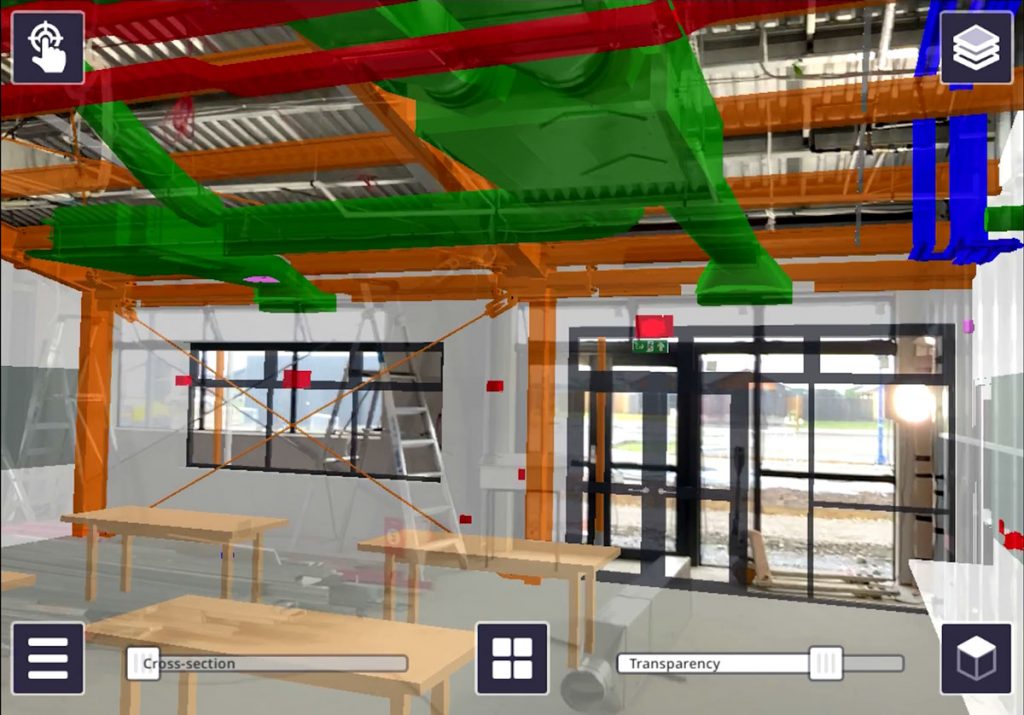
AR and AI In Various Industries – Revolutionising Construction and Agriculture
Julian Wallis
9 min read

In recent years, the integration of once thought of as futuristic technologies such as Augmented Reality (AR) and Artificial Intelligence (AI) have significantly transformed various industries, offering innovative solutions to age-old challenges.
It’s fair to say that the collaboration between artificial intelligence and augmented reality has revolutionised various business operations and user interactions with both digital and physical surroundings. AI’s capacity to emulate human intelligence, coupled with AR’s ability to enhance tangible objects in the real world, allows companies to utilise these technologies for problem-solving, predictive analysis, and the creation of immersive experiences – regardless of their industry.
This article explores two compelling use cases that showcase the power of AR & AI in revolutionising two industries that have historically stuck to traditional approaches – the construction and agriculture sectors.
Discovering The Fundamentals Of AI & AR
Let’s start with a quick debrief on these two modern technologies. Augmented Reality (AR) elevates real-world objects within a virtual platform, creating an immersive environment.
Did you know that there’s another concept that combines these two? That’s called Extended Reality (XR), which melds elements of AR and VR to produce immersive virtual environments, blurring the boundary between the digital realm and reality.
How Artificial Intelligence and Augmented Reality Work Together
AI and AR, as two transformative technologies, synergise to provide a dynamic and immersive user experience. Let’s use an example of an AI-powered chatbot to explain this further. AI-enabled chatbots enhance the interactive and conversational aspects of AR applications, while AI algorithms empower chatbots to comprehend and process natural language, enabling users to engage in overall more intuitive and meaningful conversations within the AR environment.
For instance, users can pose questions or seek information from the AR interface, and the AI-driven chatbot can deliver pertinent and context-aware responses, creating a seamless and interactive encounter almost as if you were talking to a human on the other side. Furthermore, AI amplifies AR by facilitating real-time data analysis and pattern recognition. As users interact with the AR environment, AI algorithms can analyse their actions, preferences, and behaviours.
The AI chatbot can then utilise this information to customise responses and suggestions, delivering a highly personalised AR experience. By amalgamating AI’s intelligence and learning capabilities with AR’s immersive and interactive visuals, businesses can innovate applications that transform customer engagement, training simulations, virtual shopping experiences, and more.
So that was just a theoretical example of how AR and AI collaborate to provide immersive technological solutions. How about we dive deeper into some practical implementations of these two technologies? So, without any further ado, let’s start with how the construction industry is adopting these technologies to improve different facets of their operations.
CSD Group Is Reshaping Structural Visualisation In The Construction Industry
CSD Group, a pioneering force in the construction industry, has embraced the capabilities of AR and AI to enhance client walkthroughs, structural visualisations, and layout planning directly on-site.
Utilising augmented reality models hosted online and activated by geolocated QR codes, the group has ushered in a new era of efficiency in construction environments. The cornerstone of their approach lies in combining 3D models with laser scanning, a valuable tool in their construction process.
Meet the Trimble Connect AR
One of their key tools in this transformative journey is the Trimble Connect AR software, which they are using to seamlessly integrate with Tekla models or 3D Sketchups on construction sites.
Trimble Connect AR is basically an expansion of the Trimble Connect application, offering enhanced accessibility to 3D models for building construction workers in the field. This augmented reality extension empowers users to utilise field-centric construction workflows and constructible 3D models, revolutionising everyday tasks like assembly and inspections. Essentially with Trimble Connect AR, building construction professionals can seamlessly integrate augmented reality into their work processes, optimising efficiency and accuracy on-site.
The beauty of Trimble Connect AR lies in its ability to provide a dynamic and immersive experience. Utilising iPads and iPhones, construction professionals can use Trimble Connect AR to gain insights “inside” precast concrete elements. This enables them to visualise how these elements will be installed on the construction site, facilitating a seamless comparison between the real-world environment and the digital model.
We should also shine some light on Trimble Connect AR’s user-friendly interface. The learning curve is remarkably low, especially for those already proficient in creating detailed BIM models with Tekla and who have familiarity with Trimble Connect. This means that professionals can swiftly adapt to this augmented reality tool, unlocking its full potential with minimal effort.
Perhaps the biggest benefit of this powerful tool is in improving QA/QS workflows in construction projects by allowing construction professionals to view their digital models at a 1:1 scale onsite and in context, creating an immersive and detailed visualisation experience, making it easier to detect any errors during modelling and reduce eventual rework.
In essence, the combination of Trimble Connect AR and Tekla models enhances the construction process by providing an unprecedented level of detail and accuracy. The ability to see and interact with digital models in the real-world context streamlines decision-making, minimises errors, and accelerates project timelines.

Another standout application is how CSD Group uses 3D laser scanning for clash detection. In a recent project, by scanning and generating a point cloud, the team at CSD Group identified a clash between the existing building and the new hoist gantries. And, through meticulous redesign using the point cloud, they not only saved money on reworks but also valuable time in a tight construction program.
CSD Group’s commitment to innovation is evident in their adoption of these advanced technologies, showcasing how AR and AI are not just buzzwords but powerful tools shaping the future of construction. As technology continues to evolve, we can expect even greater strides in efficiency, collaboration, and precision within the construction industry.
Agricultural Innovation with SmoothAg’s Ranch Rover
Next up we have SmoothAg, which is at the forefront of agricultural innovation, employing real-time video analytics and AI to augment the capabilities of the agricultural workforce. Sounds interesting, doesn’t it?
Their Ranch Rover, equipped with computer vision solutions from Plainsight, represents a groundbreaking advancement in autonomous vehicles tailored for the agriculture sector.
Meet The Ranch Rover
SmoothAg’s Ranch Rover is an autonomous ranching equipment designed to assist ranch operations by offering support in tasks such as feeding, livestock monitoring, and data collection. As ranch operations face increased input expenses with limited improvements in market profitability, Smooth Ag has reverted to innovation to address this challenge by integrating modern technology into traditional ranch practices.
The objective with the Ranch Rover isn’t to replace the human element of livestock farming but to enhance human capabilities, by introducing machine automation for routine tasks and thus enabling ranchers to optimise time management and workflow.
Smooth Ag’s mission starts with the Ranch Rover and extends to providing ranchers with the equipment and accompanying technology necessary to positively impact the financial outcomes of their livestock operations. Through the incorporation of advanced technology such as AI and AR, Smooth Ag seeks to empower ranchers and contribute to the overall efficiency and profitability of their agricultural endeavours.
How Does The Ranch Rover Work?
The V1 Ranch Rover autonomously navigates ranch and farm terrain to make feed deliveries, all while collecting visual data through computer vision. This data empowers ranchers with valuable insights, setting the stage for transformative applications.
SmoothAg’s Ranch Rover, armed with vision AI solutions, goes beyond automating processes. It detects, counts, and monitors ranch activity in real time, providing a repository of visual data. This data, when leveraged by ranchers, enables them to set automated alerts, predict and track trends, and make informed decisions that impact the bottom line.
Computer Vision Solutions for Agriculture
The impact of computer vision in agriculture extends beyond just autonomous vehicles. Businesses are realising the potential of this technology in addressing various challenges:
Livestock tracking and Health Oversight: The real-time automated tracking, identification, and monitoring processes eradicate manual inaccuracies, offering a vigilant approach to recognising indicators of health concerns.
Quality Assurance in Harvesting and Processing: Practices grounded in vision-based technology identify potential risks, oversee procedural aspects, and automatically implement corrective measures, ensuring a harvest that is not only timely but also of superior quality.
Detection of Ripeness in Fruits and Vegetables: Automated surveillance, considering factors such as size, shape, and colour, guarantees the production of optimised goods, thereby enhancing customer satisfaction.
Grading of Products and Packaging: A continuous commitment to quality assurance upholds predetermined standards, facilitating the delivery of products and packaging that consistently meet the elevated expectations of customers.
Management of Crops and Risk Detection: Leveraging insights derived from computer vision expedites the identification of issues, allowing for a proactive stance in guaranteeing robust high-yield production through resilient strategies.
Key Takeaways – AR and AI in Construction & Ranching
In conclusion, the convergence of AR and AI is reshaping industries, from optimising construction processes to changing the way farmers approach their day-to-day jobs in the field. As these technologies continue to advance, the possibilities for innovation and efficiency are boundless, heralding a new era of progress in various sectors.
Both CSD Group and Smooth Ag exemplify how embracing modern technologies can revolutionise traditional industries. CSD Group is innovatively embracing the use of AR and AI in construction, elevating client walkthroughs and layout planning on-site. Meanwhile, Smooth Ag’s Ranch Rover introduces autonomy to ranch operations, addressing challenges in the face of rising input expenses.
Furthermore, the convergence of 3D models, laser scanning, and computer vision along with other advanced technologies like AI and AR not only enhances efficiency but also empowers professionals in construction and agriculture.
If you’re ready to explore how these innovations can scale and grow your business, then don’t hesitate to contact us today. Let’s discuss how we can tailor these solutions to meet your unique needs and contribute to your success in leveraging the power of modern technologies.
Topics
Published On
December 04, 2023

